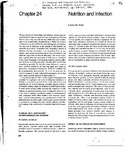Mostrar el registro sencillo del ítem
Nutrition and infection
| dc.creator | Mata Jiménez, Leonardo | |
| dc.date.accessioned | 2015-01-23T17:49:26Z | |
| dc.date.available | 2015-01-23T17:49:26Z | |
| dc.date.issued | 1984 | |
| dc.identifier.issn | ISBN-10: 0070683271 | |
| dc.identifier.uri | https://hdl.handle.net/10669/11291 | |
| dc.description | capítulo de libro -- Universidad de Costa Rica, Instituto de Investigaciones en Salud. 1984. | es_ES |
| dc.description.abstract | The association of malnutrition and infectious disease (faminepestilence) had been recognized since the beginning of human history, but it was not until the late 1950s that such an interaction was scientifically documented [I]. While the presence of infection was recorded in the early descriptions of kwashiorkor, the role of infection in the genesis of malnutrition was generally overlooked. Synergistic and antagonistic models of nutrition-infection interactions were described [1,2]. In synergism, malnutrition exacerbates the outcome of infection, and infection aggravates nutritional deficiency; the result supposedly is greater than the summation of both factors. Synergism occurs more frequently in developing countries because infectious diseases are highly prevalent, and diets often are deficient in quality or quantity. On the other hand, deficiency in one or more nutrients needed by an infectious agent may impair its replication, an antagonist interaction. While this condition can be experimentally demonstrated [2], it is not generally observed in humans in their undisturbed ecosystems. but it does occur under extreme nutritional deprivation [3]. Long-term prospective field studies in poor rural populations revealed the importance of nutrition-infection interactions in determining morbidity, growth failure, acute malnutrition, and mortality [4 —7] . Growth faltering invariably begins at about 3 to 6 months among infants at the breast in traditional societies. or even earlier among infants prematurely weaned as in populations in transition adopting bottle-feeding [8]. However, it is not clear if stunting is primarily related to supplementation with inadequate foods when mother's milk becomes insufficient, or to infectious disease, or to an interaction of both [9]. Inadequate human milk supply without proper supplementation is common in developing societies, but the striking event during weaning is the occurrence of repetitive infectious diseases | es_ES |
| dc.description.sponsorship | Universidad de Costa Rica, Instituto de Investigaciones en Salud | es_ES |
| dc.language.iso | en_US | es_ES |
| dc.publisher | Tropical and Geographical Medicine. New York: McGraw-Hill, pp. 206-211 | es_ES |
| dc.subject | Desnutrición | es_ES |
| dc.subject | Dieta | es_ES |
| dc.subject | Nutrición | es_ES |
| dc.title | Nutrition and infection | es_ES |
| dc.type | capítulo de libro | |
| dc.description.procedence | UCR::Vicerrectoría de Investigación::Unidades de Investigación::Ciencias de la Salud::Instituto de Investigaciones en Salud (INISA) | es_ES |
Ficheros en el ítem
Este ítem aparece en la(s) siguiente(s) colección(ones)
-
Nutrición [253]


